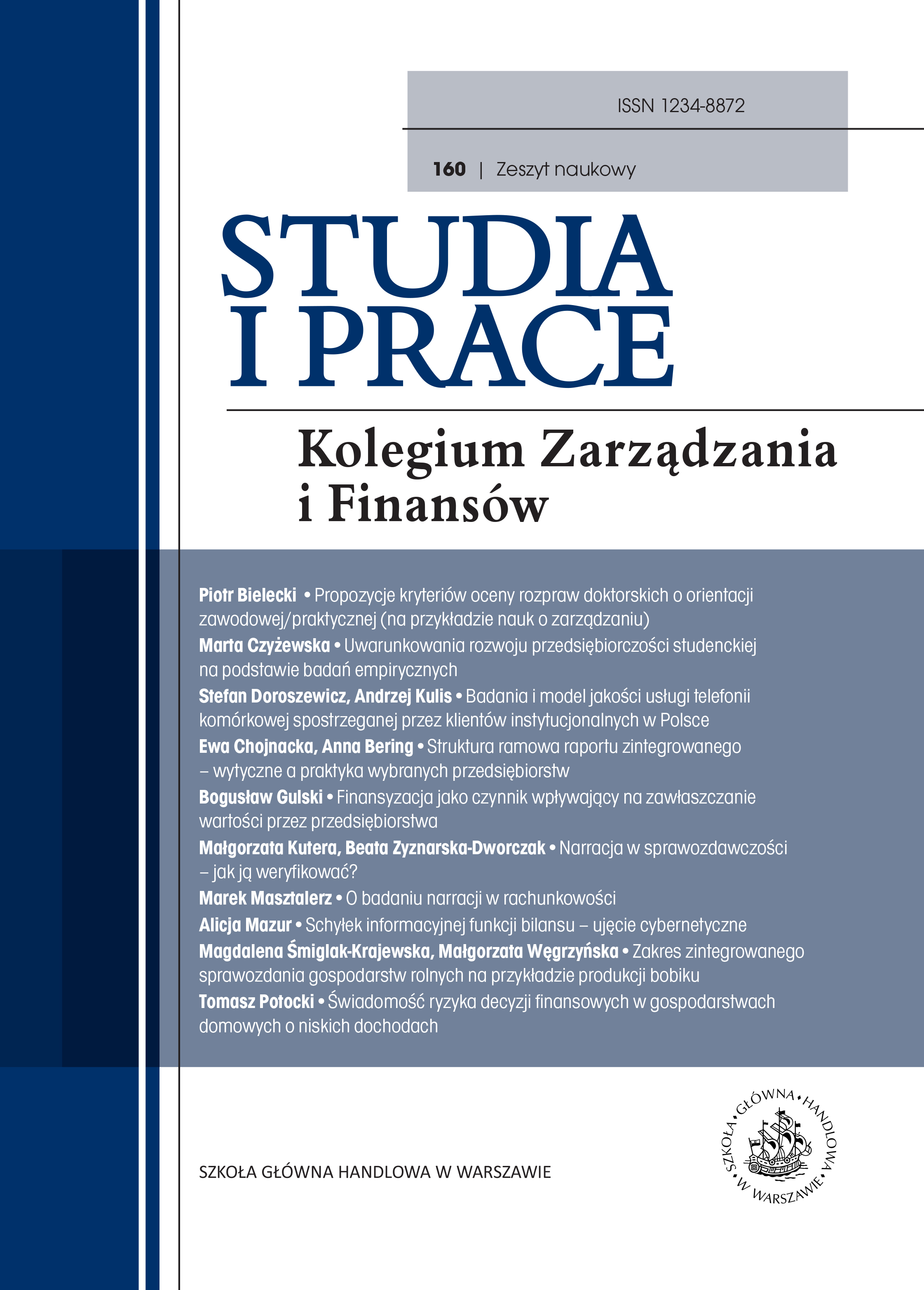Integrated Report Framework Structure. Guidelines and Practice in Selected Enterprises
DOI:
https://doi.org/10.33119/SIP.2018.160.4Keywords:
integrated report, reporting standardisation, non-financial reporting, usefulness of information, comparability of informationAbstract
The article is aimed at the presentation of guidelines included in the framework structure of integrated reporting as well as an attempt to refer them to the scope of information disclosed in reports. The selection of analysed companies results from the desire to compare the contents of Polish and foreign reports made by entities operating within the fuel and energy sector, characterised by different experience in integrated reports preparation. The article makes use of the following research methods: critical analysis of literature studies, integrated report content analysis or case studies. The analysed companies disclose different contents within the assessed areas, which results from different conceptual frameworks of integrated reporting. It seems desirable to standardise the scope of presented information to a certain extent in order to increase comparability between entities.
Downloads
References
1. Dyrektywa Parlamentu Europejskiego i Rady 2014/95/UE z dnia 22 października 2014 r.
zmieniająca dyrektywę 2013/34/UE w odniesieniu do ujawniania informacji niefinansowych
i informacji dotyczących różnorodności przez niektóre duże jednostki oraz grupy, Dz. Urz. UE
L 330/1 z 15.11.2014 r.
2. Ustawa z dnia 29 września 1994 roku o rachunkowości, tekst jedn.: Dz.U. 2018, poz. 395
Wydawnictwa zwarte
1. Krasodomska J., 2014, Informacje niefinansowe w sprawozdawczości spółek, Wydawnictwo
Uniwersytetu Ekonomicznego, Kraków
2. Roszkowska P., 2011, Rewolucja w raportowaniu biznesowym. Interesariusze, konkurencyjność,
społeczna odpowiedzialność, Difin, Warszawa
3. Samelak J., 2013, Zintegrowane sprawozdanie przedsiębiorstwa społecznie odpowiedzialnego,
Wydawnictwo Uniwersytetu Ekonomicznego w Poznaniu, Poznań
4. Walińska E., Bek-Gaik B., Gad J., Rymkiewicz B., 2015, Sprawozdawczość przedsiębiorstwa
jako narzędzie komunikacji z otoczeniem. Wymiar finansowy i niefinansowy, Wydawnictwo
Uniwersytetu Łódzkiego, Łódź
Artykuły prasowe i okolicznościowe
1. Bek-Gaik B., Rymkiewicz B., 2016, Tendencje rozwoju sprawozdawczości zintegrowanej w praktyce
polskich spółek giełdowych, „Finanse, Rynki Finansowe, Ubezpieczenia”, nr 1
2. Bek-Gaik B., 2017, Sprawozdawczość zintegrowana – przegląd badań, „Zeszyty Teoretyczne
Rachunkowości”, nr 92 (148)
3. Disclosure Initiative – Principles of Disclosure, Discussion Paper DP/2017/1, IASB, materiały
z Europejskiej Konferencji Konsultacyjnej w sprawie Dokumentu Dyskusyjnego IASB nt. Inicjatywy
ws. ujawnień – Zasady ujawnień z dnia 12 września 2017 r.
4. Dumitru M., Glavan M. E., Gorgan C., Dumitru V. F., 2013, International Integrated Reporting
Framework: A case study in the software industry, „Annales Universitatis Apulensis Series
Oeconomica”, nr 15 (1)
5. Jędrzejka D., 2012, Raportowanie zintegrowane jako nowe podejście do współczesnej sprawozdawczości,
„Acta Universitatis Lodziensis. Folia Oeconomica”, nr 266
6. Karmańska A., 2014a, The imperative of sustainable growth and reporting integration. The
fourth era in the corporate reporting development, „Copernican Journal of Finance & Accounting”,
vol. 3, no. 2
7. Karmańska A., 2014b, The imperative of sustainable growth and reporting integration. Three
eras in the corporate reporting development, „Copernican Journal of Finance & Accounting”,
vol. 3, no. 1
8. Macuda M., 2015, Rachunkowość odpowiedzialności społecznej – raportowanie zagadnień środowiskowych,
„Studia Oeconomica Posnaniensia”, vol. 3, no. 1
9. Tatarska M., 2013, Sprawozdawczość zintegrowana na przykładzie Grupy Lotos S. A., „Prace
Naukowe Uniwersytetu Ekonomicznego we Wrocławiu”, nr 314
10. Walińska E., 2015, Zintegrowany raport – początek końca sprawozdania finansowego?, „Zeszyty
Teoretyczne Rachunkowości”, nr 82 (138)
11. Zyznarska-Dworczak B., 2015, Wiarygodność raportowania zintegrowanego w świetle strategiczno-
informacyjnego paradygmatu rachunkowości, „Studia Oeconomica Posnaniensa”,
vol. 3, no. 1
Materiały internetowe
1. GRI and IIRC deepen cooperation to shape the future of corporate reporting, https://integratedreporting.
org/news/gri-and-iirc-deepen-cooperation-to-shape-the-future-of-corporatereporting/,
dostęp 20.10.2017
2. IIRC finalises its Framework for integrated reporting, http://www.iasplus.com/en/news/2013/12/
iirc, dostęp 25.11.2016
3. The International Integrated Reporting Framework, http://integratedreporting.org/resource/
international-ir-framework/, dostęp 25.11.2016
4. http://cpfl.riweb.com.br/Show.aspx?id_canal=PcPFCLtTdcL1F/kigVmi6 w==, dostęp
18.06.2016
5. http://easywork.comunique-se.com.br/arq/160/arq_160_233918.pdf, dostęp 18.06.2016
6. http://raportzintegrowany.orlen.pl/pl/nasza-firma/kim-jestesmy/grupa-orlen, dostęp
15.04.2016
7. http://www.ey.com/Publication/vwLUAssets/ey-excellence-in-integrated-reporting-awards-
2015/$FILE/ey-excellence-in-integrated-reporting-awards-2015.pdf, dostęp 18.06.2016
8. http://www.lotos.pl/50/poznaj_lotos, dostęp 13.04.2016
9. https://www.lotos.pl/1412/a,264/poznaj_lotos/nagrody/poznaj_lotos/nagrody/the_best_
annual_report_2014, dostęp 15.04.2016
10. http://www.orlen.pl/PL/BiuroPrasowe/Strony/Raport-roczny-PKN-ORLEN-za-2014‑z-czterema-
nagrodami-w-X-edycji-konkursu-The-Best-Annual-Report.aspx, dostęp 15.04.2016
11. http://www.sasol.com/about-sasol/company-profile/overview, dostęp 7.06.2016









